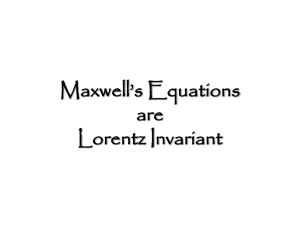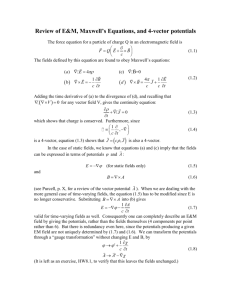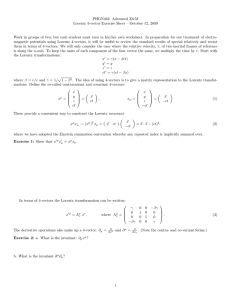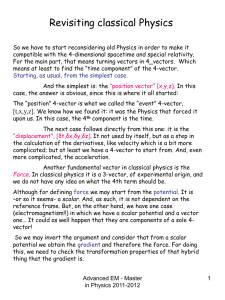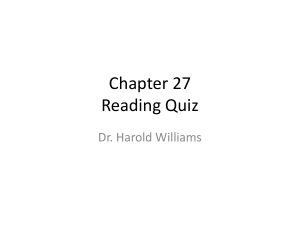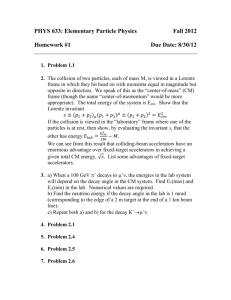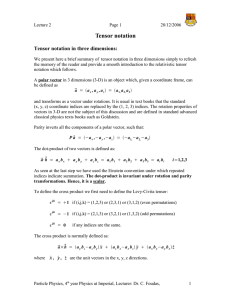PPT
advertisement
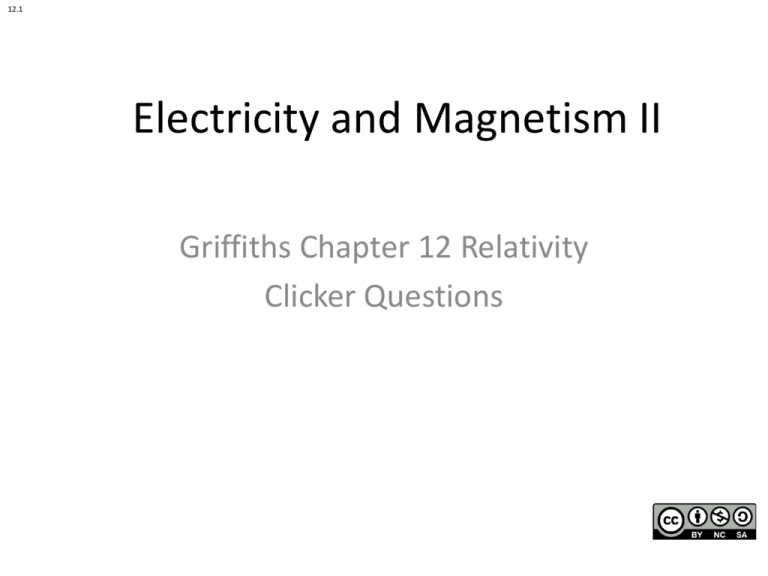
12.1 Electricity and Magnetism II Griffiths Chapter 12 Relativity Clicker Questions 12.2 Two major results of special relativity are Time Dilation and Lorentz Contraction. Please pick one of the choices below which best describes how well you feel you understand them. A. No idea what these effects are B. I remember having heard about these, but couldn’t define them precisely right now. C. I know what these effects are, (but I’ve forgotten how to derive them) D. I know what these effects are, and I even sort of remember the derivation, but it would take me a while to sort it out E. I’m confident I could derive these results right now 12.3 A rocket is moving to the right at speed v = (3/4)c, relative to Earth. On the front of the rocket is a headlight which emits a flash of light. light beam v = (3/4) c v = 3/4c v=0 In the reference frame of a passenger on the rocket, the speed of the light flash is A) c B) 7/4 c C) 1/4 c D) None of these According to a person at rest on the earth, the speed of the light flash is A) c B) 7/4 c C) 1/4 c D) None of these According to a person moving toward the rocket at speed (3/4)c, relative to earth, the speed of the light flash is A) c B) 7/4 c C) 1/4 c D) None of these 12.4 A light bulb flashes in the center of a train car that is moving at speed v with respect to the ground. In the frame of reference of the train car, light wave from the flash strikes the front and back of the train simultaneously. In the frame of reference of the ground, the light strikes the back of the train ___________ (fill in the blank) the light strikes the front of the train. A) before B) after C) at the same time as v Ground frame Events that are simultaneous in one frame are not simultaneous in other frames. There is no such a thing as “now”. The time “now” in the Andromeda galaxy, depends on whether we are in the Earth rest frame or the Andromeda rest frame, or… 12.5 Light clock v Rest frame of clock Δt0 Moving frame Δt In which frame of reference is the time between tics of the clock longer? A) Rest frame of clock B) moving frame C) no difference “Moving clocks run slower”: t t 0 12.6 I have a stick of length L sitting in front of me. In the reference frame of a passing train,(moving parallel to the stick) what is the measured length of the stick? A) L B) g L C) L / g D) I’m sure it’s either B or C, but I’m NOT sure which one! E) I’m pretty sure it’s “none of the above” or “it depends” 12.7 I flash a lightbulb (event 1). The light reaches a mirror, and returns to me (event 2) I measure the time Δt =t2-t1 for the complete trip of the light. A long train was passing (speed v) during this experiment. In the reference frame of the train, what is the interval Δt’ between those two events? (As usual, g º A) Dt'= Dt 1) 1- v 2 / c 2 B) Dt'=g Dt C) Dt'=Dt / g D) I’m sure it’s either B or C, but I’m NOT sure which one! E) I’m pretty sure it’s “none of the above” 12.8 Lorentz Transformations We now have the tools to compare positions and times in different inertial reference frames. In Galilean relativity In Special relativity x x vt y y x ( x vt) y y z z t t z z x ( x vt ) y y z z v t (t 2 x) c v t (t 2 x) c Newton worked with these… but needs reworking of momentum and energy to work with these! 12.9 I have a stick of length L sitting in front of me. In the reference frame of a passing train,(moving parallel to the stick) what is the measured length of the stick? A) L B) g L C) L / g D) I’m sure it’s either B or C, but I’m NOT sure which one! E) I’m pretty sure it’s “none of the above” or “it depends” 12.10 Can one change the order of events in time by measuring them in a different inertial reference frame? A. Always B. Sometimes C. Never 12.11 The interval between two particular events is positive: I (d) (ct) 0 2 2 Could these events be causally connected? That is, could one of these events have caused the other? A) Yes B) No C) Answer depends on the frame of reference 12.12 A clock flies over a town at high speed (constant velocity). In the rest frame of the town, the clock reads 0 when it is over the church steeple and it reads 2 when it is over the Old Watch Tower. So according the townsfolk, the flying clock face advanced 2 units between these two events. Do observers in all other references frames agree that the flying clock face advanced 2 units between these two events? A) Yes B) No 12.13 Is the time interval Δt between two events Lorentz invariant? A) Yes B) No t Is the proper time interval between two events Lorentz Invariant? A) Yes B) No 12.14 The displacement between two events Δxm is a 4-vector. Is 5Δxm also a 4-vector? A) Yes B) No Is Δxm /Δt a 4-vector? A) Yes B) No Is Δxm /Δτ a 4-vector? A) Yes B) No 12.15 I’m in frame S, and Charlie is in Frame S’ (which moves with speed V in the +x direction.) An object moves in the S’ frame in the +y direction with speed v’y. Do I measure its y component of velocity to be vy =vy’? A) Yes B) No C) ??? 12.16 Displacement is a defined quantity: m m m x x A x B Is displacement a 4-vector? A) B) C) D) Yes No Ummm… don’t know how to tell None of these. Be ready to explain your answer. 12.17 Which of the following equations is the correct way to write out the Lorentz product? A) aib = -a b + a b + a b + a b 0 0 1 1 2 2 3 3 B) aib = +a0b0 + a1b1 + a2b 2 + a3b3 C) aib = am b m D) More than one (but not all three) E) All three are equally correct 12.18 Velocity is a defined quantity: Dr æ Dx uº =ç Dt è Dt Dy Dt Dz ö ÷ Dt ø In another inertial frame, seen to be moving to the right, parallel to x, observers see: Dr ¢ æ Dx ¢ Dy ¢ u¢ º =ç Dt ¢ è Dt ¢ Dt ¢ Is velocity a 4-vector? Dz ¢ ö ÷ Dt ¢ ø A) Yes B) No C) Sometimes yes, sometimes no D) None of these. 12.19 c 4-velocity? x t Imagine this quantity: u m y t z Is this quantity a 4-vector? t A) Yes, and I can say why. B) No, and I can say why. C) None of the above. 12.20 c 4-velocity? x t Imagine this quantity: u m y t z Is this quantity a 4-vector? t A) Yes, and I can say why. B) No, and I can say why. C) None of the above. This object does not Lorentz Transform. NOT a a 4-vector. 12.21 4-velocity? ct 1 x m Imagine this quantity: y z Is this quantity a 4-vector? A) Yes, and I can say why. B) No, and I can say why. C) None of the above. Proper time 12.22 Can we define? c x m x Proper time m 2 2 2 c t x y z 2 2 Is this a reasonable definition? A) Yes, and I can say why. B) No, and I can say why. C) None of the above. 12.23 Displacement is a defined quantity: Interval is a defined quantity: x x x m I xm x m A m Written in terms of the spatial distance, d, between events and the times separation between events, t, the interval is: A) Working on it. B) Think I’ve got it. C) None of the above. m B 12.24 In my frame (S) I measure two events which occur at the same place, but different times t1 and t2 (they are NOT simultaneous) Might Charlie (in frame S’) measure those SAME two events to occur simultaneously in his frame? A) B) C) D) Possibly, if he’s in the right frame! Not a chance Definitely need more info! ??? 12.25 The 4-velocity ημ is defined as c h = ( ) 2 2 u 1- u / c m 1 What is the invariant length squared of the 4-velocity, ημημ? A. B. C. D. E. c2 -c2 -c2 + u2 c 2 – u2 None of the above 12.26 Two events have a timelike separation. In a “1+1”dimensional spacetime (Minkowski) diagram (x horizontal, ct vertical), the magnitude of the slope of a line connecting the two events is A. Greater than 1 B. Equal to 1 C. Less than 1 12.27 For isolated systems, the total 4-momentum is CONSERVED (this is an experimental fact). Is 4-momentum invariant ? A) Yes, and I can say why. B) No, and I can say why. C) None of the above. 12.28 The rest mass m of an object is the mass measured in the rest frame of the object. m m Is p m a 4-vector ? A) Yes B) No C) Sometimes 12.29 pm = [g mc, g m u] m ( ) ( 2 pm p = - g mc + g m u ) 2 What is the invariant length-squared of the 4-momentum, pμpμ ? A. B. C. D. E. +(mc)2 – (mc)2 – (mc)2 + (mu)2 +(mc)2 – (mu)2 None of the above 12.30 A row of positive charges is stationary on the ground. A person with a gauss-meter is running to the right along the row of charges, at the same height as the charges and in front of them. What is the direction of the B-field which the observer measures? A) Right B) left C) up D) down E) B = 0 12.31 Are energy and rest mass Lorentz invariants? A. B. C. D. Both energy and mass are invariants Only energy is an invariant Only rest mass is an invariant Neither energy or mass are invariants 12.32 Are energy and rest mass conserved quantities? A. B. C. D. Both energy and mass are conserved Only energy is conserved Only rest mass is conserved Neither energy or mass are conserved 12.33 Components of magnetic and electric fields parallel to the relative velocity of two reference frames are transformed between frames by being A. B. C. D. E. Multiplied by γ Multiplied by β Multiplied by γβ Multiplied by 1 None of the above 12.34 A charge q is moving with velocity u in a uniform magnetic field B. F = q u ´ B = ma If we switch to a different Galilean frame (a low speed Lorentz transform), is the acceleration a different? S A) yes B) No S’ u q Is the particle velocity u different? A) yes Is the B-field different? A) yes B) No B) No Suppose we switch to frame with v = u, so that in the primed frame, u’ = 0 (the particle is instantaneously at rest). Does the particle feel a force from an E-field in this frame? A) Yes B) No C) depends on details v << c 12.35 Switch from frame S to frame S-bar: S S +s v -s +s -s Frame S (at rest) v Frame S How does Ex compare to Ex ? A) E x E x B) E x E x C) E x E x 12.36 Switch from frame S to S-bar. Things change: t® t x®x y®y z®z E x ® E x Bx ® Bx E y ® E y etc S S v Do Maxwell’s Equations look the same in S-bar? r Ñ× E = e0 A) Yes ????? ® B) No ¶E x ¶E y ¶E z r Ñ×E = + + = ¶x ¶y ¶z e0 12.37 Can we define a 4-force via the 4-momentum? dp m = Km dt Proper time Is K, so defined, a 4-vector? A) Yes, and I can say why. B) No, and I can say why. C) None of the above. 12.38 Minkowski 4-force To match the behavior of non-relativistic classical mechanics, we might tentatively assign which of the following values to K: A) K 1,2,3 = F =F g B) K 1,2,3 C) K 1,2,3 = g F D) Something else 12.39 Consider the equation ¶G mn =0 n ¶x How many ordinary equations is that, really? A) B) C) D) E) 1 4 6 16 ????
